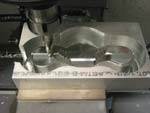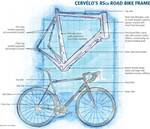Software eases design/build for exotic exercise bike
The Lamiflex Group (Bergamo, Italy) helps Milan, Italy-based design house Luca Schieppati develop the Ciclotte, a striking luxury exercise bicycle made with carbon fiber composites.
Known for its thermoset composites expertise in aerospace, medical and other sectors, the Lamiflex Group (Bergamo, Italy) was contacted in 2009 by the Milan, Italy-based design house Luca Schieppati to help develop the Ciclotte, a striking luxury exercise bicycle made with carbon fiber composites and equipped with a touch-screen display and reduced pedal distance to ensure better bio-mechanics. The project was facilitated with the VISI suite of design and manufacturing tools from Vero Software Ltd. (Gloucestershire, U.K.). Ciclotte, first unveiled in late 2010, was a recent nominee for the JEC Innovation Award in the Sports and Leisure category.
“The concept from Luca Schieppati excited us, and we wanted to help bring the product to life, using our composites experience,” explains Federico Carrara Castelli, research and development director at Lamiflex and the Ciclotte project leader.
With a large central wheel as its design cornerstone, the Ciclotte was engineered to accurately reproduce the dynamics and performance of on-road pedaling for high-intensity “spinning,” with an innovative epicycloid crank system — a set of eccentric gears that turn the wheel. To guarantee the exact requirements and size of all the mechanical components, including the large carbon fiber wheel, handlebar and saddle, Lamiflex wanted to design all components in 3-D and virtually assemble them to highlight potential issues prior to production of molds and parts.
“Previously, we had a parametric CAD system that we found difficult to use and quite restrictive when working with complex organic surface forms,” notes Lamiflex CAD designer Marco Perani. “After extensive testing, we decided to implement VISI. We believed it offered the best balance between performance and price for an integrated CAD/CAM system. We are currently running VISI Modelling and VISI Analysis, and VISI Machining with Compass Technology for 2-D through to 5-axis milling.”
The software also was used to design, in less than 100 hours, the carbon/epoxy molds to produce the Ciclotte parts. When the molds were complete, woven carbon fabric wet out with epoxy resin was hand layed, vacuum bagged and cured in the company’s autoclave. Then the parts were passed to the CAM department for finish machining. With VISI Machining software, the machine operator can walk through the complete program virtually, using its kinematic simulator, and prove that the toolpath is collision-free for all drilling and trimming.
“VISI software has streamlined our manufacturing processes, reduced the potential for error and ultimately increased our productivity,” says Castelli.
Related Content
-
Active core molding: A new way to make composite parts
Koridion expandable material is combined with induction-heated molds to make high-quality, complex-shaped parts in minutes with 40% less material and 90% less energy, unlocking new possibilities in design and production.
-
ASCEND program update: Designing next-gen, high-rate auto and aerospace composites
GKN Aerospace, McLaren Automotive and U.K.-based partners share goals and progress aiming at high-rate, Industry 4.0-enabled, sustainable materials and processes.
-
Nine factors to consider when designing composites cure tooling
Gary Bond discusses the common pitfalls and compromises when designing good cure tooling and their holistic significance for a robust composite production process.














